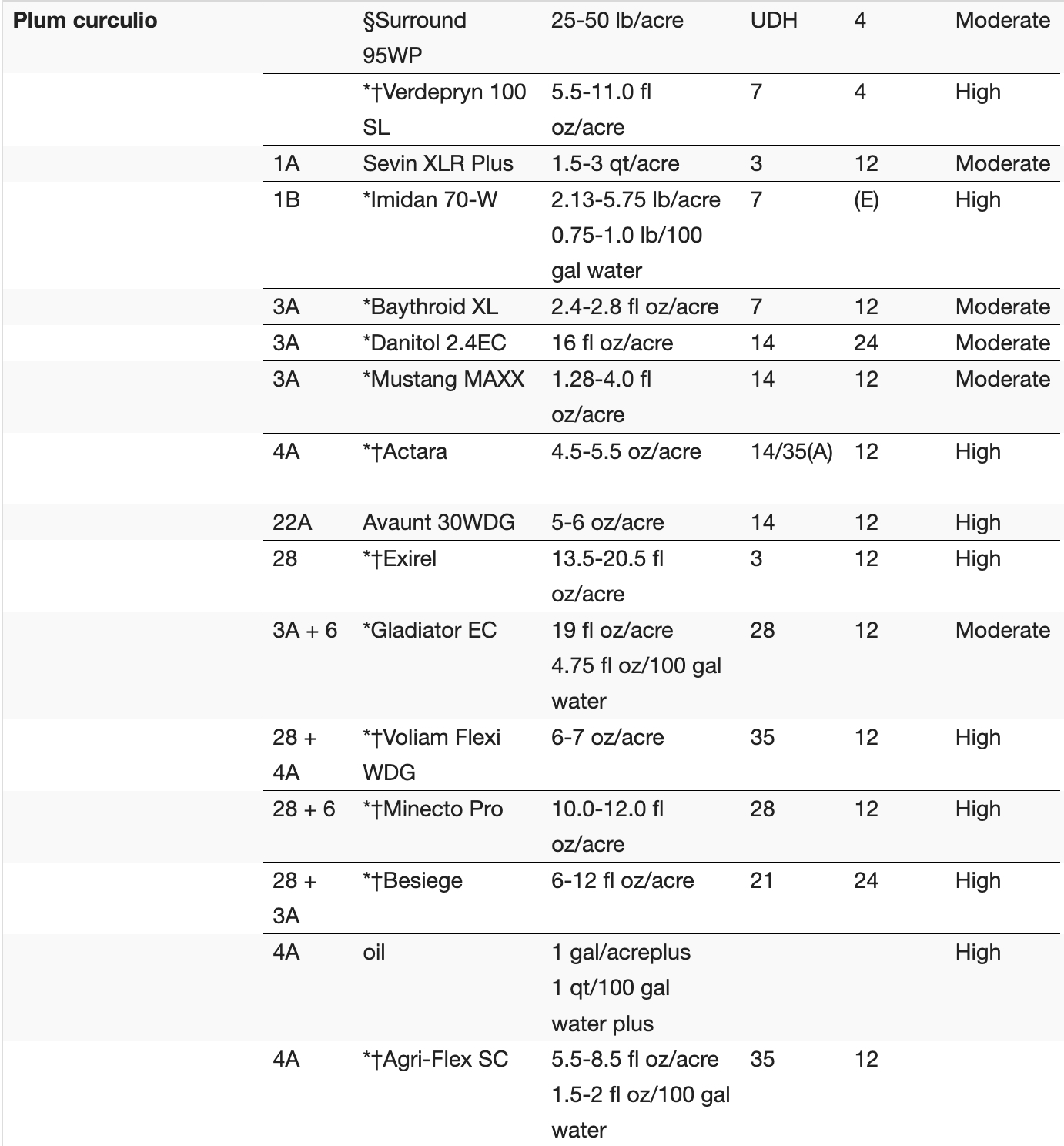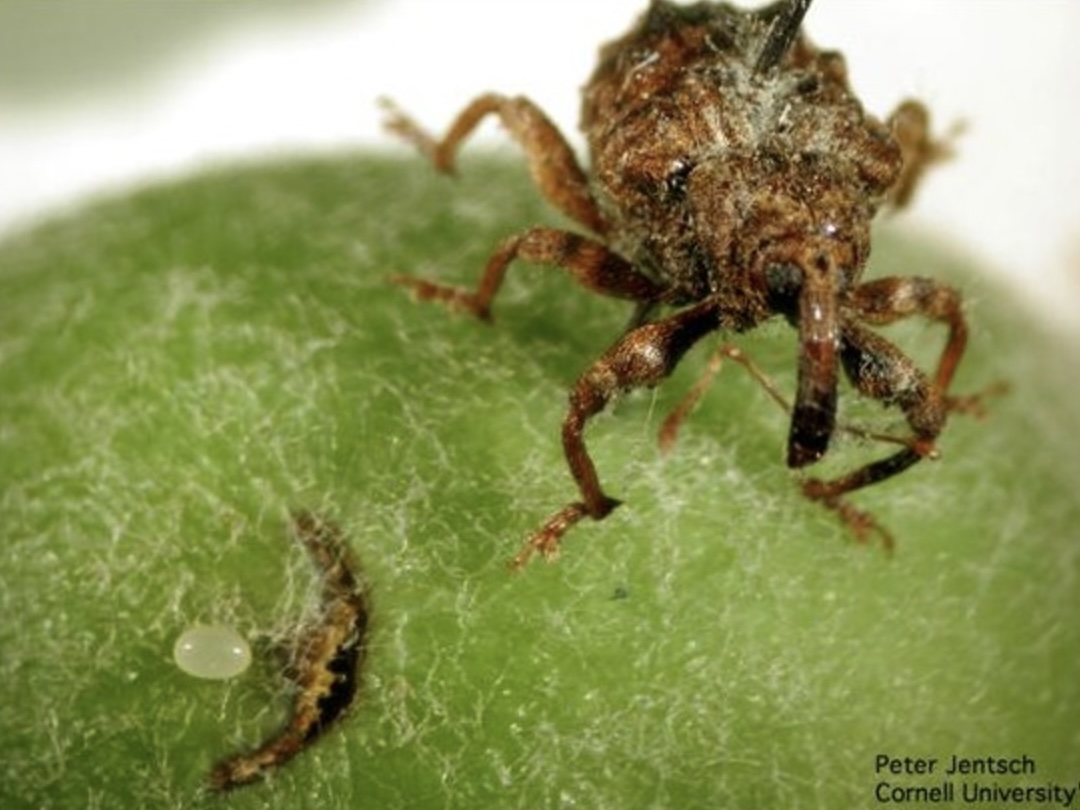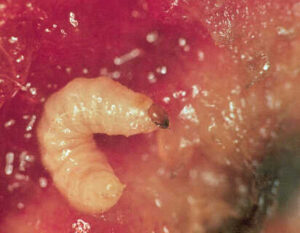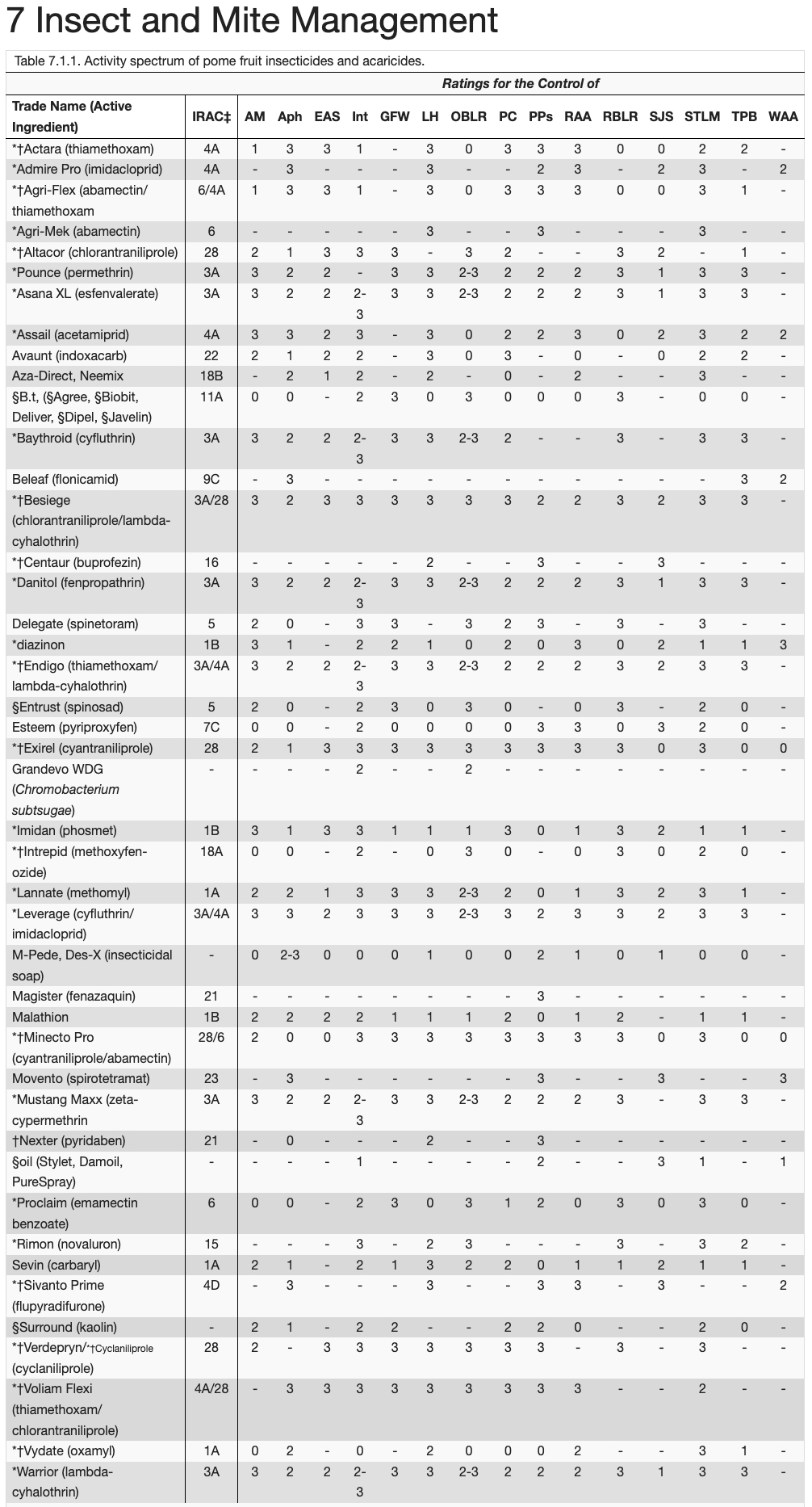Curculio Draws Nigh: Stone Fruit At Greatest Risk As Apple Bloom Wains.
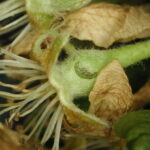
Overview: Plum Curculio (PC)(Conotrachelus nenuphar) and apple curculio adults have been found in Mid-Hudson Valley traps, employing a Benzaldehyde lure and Tedders Traps, over the past 10 days. Sustained rain driven cool temperature have kept PC from its migration into orchards as early varieties reach the >5mm diameter, begining the fruit stage of vulnerability to PC. Seasons in which warm evening temperatures, daytime highs in the 70’s and ample light intensity is present prompt this insect complex to begin flying, feeding, and reproducing. However, the forecast temperatures for the next few days are predicted to reach only into the mid-60’s.
Yet, stone fruit, cherry, plum and apricot, will be the ‘Canary in the Coal Mine’ and most vulnerable to low levels of PC moving into the orchard to begin laying eggs into the cuts made to fruit exceeding 5mm in diameter. Management of PC to these crops should be made at the first sign of activity and is critical at this time to reduce economic losses from this pest.
As of last night, I have not seen PC injury to untreated pear, cherry or peach. An unsprayed border sentinel tree, such as cherry or plum, is a good tell tale for finding the first signs of PC injury. Upon the first sting, management should begin in earnest.
As we are not seeing a large disparity yet between king and lateral fruit size within and across varieties. Fruit may be >5mm with many clusters still at early bloom. Selecting insecticides with no contact activity to our pollinators is critical for bees to continue pollinating.
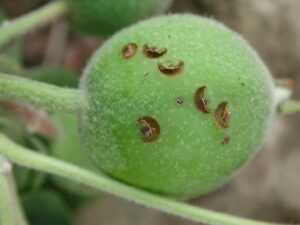 Up to this point, evening temperatures have been hovering at or below 58F. PC activity is highly dependent upon temperatures, particularly at night when adults are most active. PC typically do not feed or oviposit when nighttime temperatures are below 50 deg F. In cooler seasons, PC may continue to delay with extended oviposition for 4-6 weeks. As the adults begin to move in cooler weather, they often crawl instead of fly or fly short distances, damaging fruit along the edge first, moving among trees into the orchard center from the edge in commercial orchards. Applications to border trees using bee safe materials may reduce early injury as fruit set, bloom wains and pollination continues.
Up to this point, evening temperatures have been hovering at or below 58F. PC activity is highly dependent upon temperatures, particularly at night when adults are most active. PC typically do not feed or oviposit when nighttime temperatures are below 50 deg F. In cooler seasons, PC may continue to delay with extended oviposition for 4-6 weeks. As the adults begin to move in cooler weather, they often crawl instead of fly or fly short distances, damaging fruit along the edge first, moving among trees into the orchard center from the edge in commercial orchards. Applications to border trees using bee safe materials may reduce early injury as fruit set, bloom wains and pollination continues.
Milton, NY presently has 308 accumulated degree days (base 50°F BE) from Jan. 1st with fruitlet sizes in Ginger Gold and Ruby Frost exceeding 5mm, across early to mid-blooming varieties. Control measures for PC are needed from PF through 1st and occasionally 2nd cover. In years in which cooler weather prevails and extended PC activity occurs, a 2nd cover may be required. PC management is only needed until 308 degree days have accumulated since petal fall. Petal Fall of McIntosh occurred Monday May 5th in Highland, a relatively warm site near the Hudson River. Monitoring this event over the next few weeks can be done using the Access link to the NEWA Model for PC.
Applications for plum curculio should control the pest for about 10-14 days based on materials and weathering.
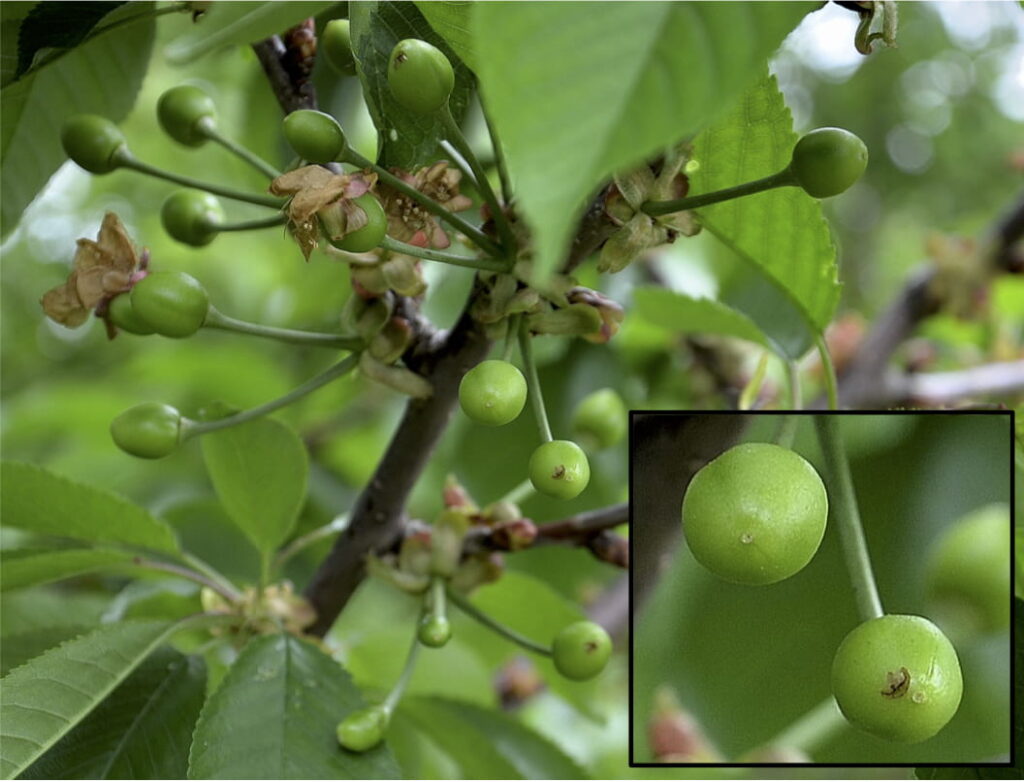
Stone fruit (cherry) sentinel for onset of emerging Plum Curculio egg laying and fruit feeding activity in spring.
As PC damage often occurs in the same locations in orchards year after year, PC injury is fairly predictable from past observations. Frequent short interval rains will remove surface contact insecticide residual. A short interval, from petal fall to 1st cover (<7-10 days), should be employed for PC management even if residual efficacy is not compromised by rain events.
Maintaining control of PC during the migration period is essential. If a delay in emergence of PC occurs as cool temperatures return next week, management of PC, even in low-pressure orchards, may be prolonged. In high-pressure orchards, additional sprays along the perimeter of the orchards should be considered until the oviposition model predicts that control is no longer necessary.
Remember to keep codling moth on the radar after PF if border applications are not followed up with whole orchard applications. If alternate row applications (ARM) are used, be aware that ARM are very effective against mobile insects such as PC and apple maggot, but less so with sedentary, less mobile insects such as obliquebanded leafroller (OBLR).
Insecticides effective against the PC include a broad list of materials that can be found in the Cornell Guidelines. A few of these include…Avaunt 30WDG (indoxacarb), the neonicotinoid Actara 25WDG (thiamethoxam), the OP Imidan 70WP, WSP (Phosmet), carbamate; Sevin (carbaryl), and pyrethroids Danitol 2.4EC (fenpropathrin), Asana XL (esfenvalerate), Baythroid XL 1E, 2EC (beta-cyfluthrin), Lambda-Cy 1CS (lambda-cyhalothrin), Warrior 1CS (lambda-cyhalothrin), Proaxis 0.5CS, and pre-mix formulations Endigo ZC (lambda-cyhalothrin / thiamethoxam), Leverage 360 (imidacloprid / beta-cyfluthrin), Gladiator (zeta-cypermethrin / avermectin), Voliam Express (lambda-cyhalothrin / thiamethoxam), Voliam Flexi (chlorantraniliprol / thiamethoxam).
The pyrethroids and phosmet have broad spectrum activity to include PC, EAS, lepidopteran larva (OFM, CM, Lesser appleworm (LAW) and Obliquebanded leafroller (OBLR). They have no activity against rosy apple aphid (RAA) in curled foliage.
Rosy apple aphid control after leaf curl is best accomplished using a neonicotinoid insecticide such as Admire Pro, Assail or Actara 25WDG.
The pre-mix ingredient notes:
Avermectin (AgriMek, Gladiator…) must be used with a penetrant at the proper rate to effectively move into leaf tissue for mite management.
Chlorantraniliprol, the active in Altacor, is excellent against the range of lepidopteran larva with limited spectrum on other arthropod pests.
Thiomethoxam (Actara) has virtually no efficacy against internal lepidopteran larva. Exclusive use of this product at 1st Cover will put you at risk for CM larval injury.
Lep Complex: Oriental Fruit Moths (OFM) flight has begun in earnest over the past week and moving toward peak flight. OFM eggs from the first generation are being lain. A petal fall spray should include an insecticide with lepidopteran activity for the parade of ‘worms’ including OFM, Red banded Leafroller, Speckled Green Fruitworm, Obliquebanded Leafroller larva, Spongy Moth and various forest geometrids….ie inchworms or measuring worms, known for their distinctive “measuring” movement.
Additional applications will also be applied at about 10-14 days after petal fall for the Lep. Complex, primarily Codling Moth, that will also reduce OFM. This second spray against the first generation of OFM is particularly important in high-pressure orchards (past history of OFM fruit damage or high pheromone traps catches, (>10/ trap/ week) to control the remainder of hatching larvae. If this spray is applied at the normal time of a first cover spray (10-14 days after petal fall) it will also control early hatching CM larvae from the first flight of adults.
Codling Moth (CM) flight has yet to occur, and will likely begin over the next 5-10 days. If this occurs, then egg-laying will likely begin within the next 2-3 weeks. The first eggs will hatch after 220 DD from first sustained trap capture. Insecticides that need to be present before egg laying (Rimon) should be applied at about 50-75 DD, made shortly after sustained flight. Apply insecticides that target early egg laying period at 100-200 DD. Remember, Actara 25WDG employed at 4.5-5.5 oz/acre is excellent against PC but has no commercial value to manage the lepidopteran complex, specifically codling moth. Select materials with highest efficacy rating against CM if past crops have had internal feeding or stings from CM.
